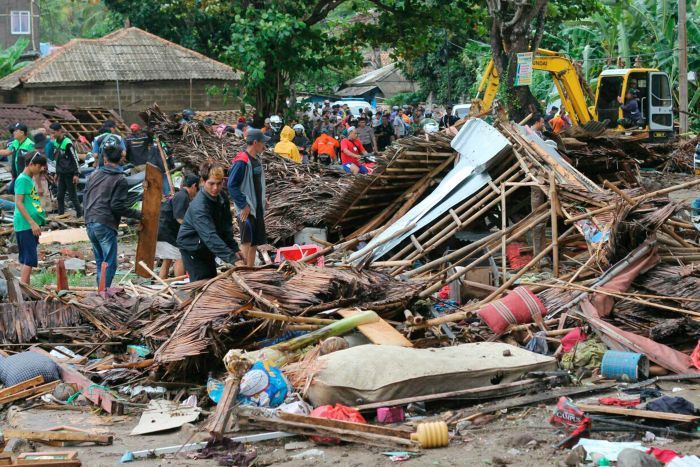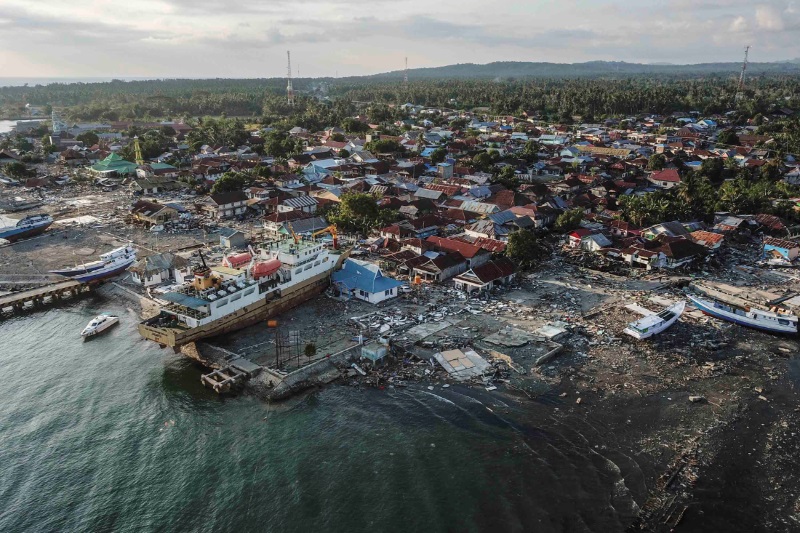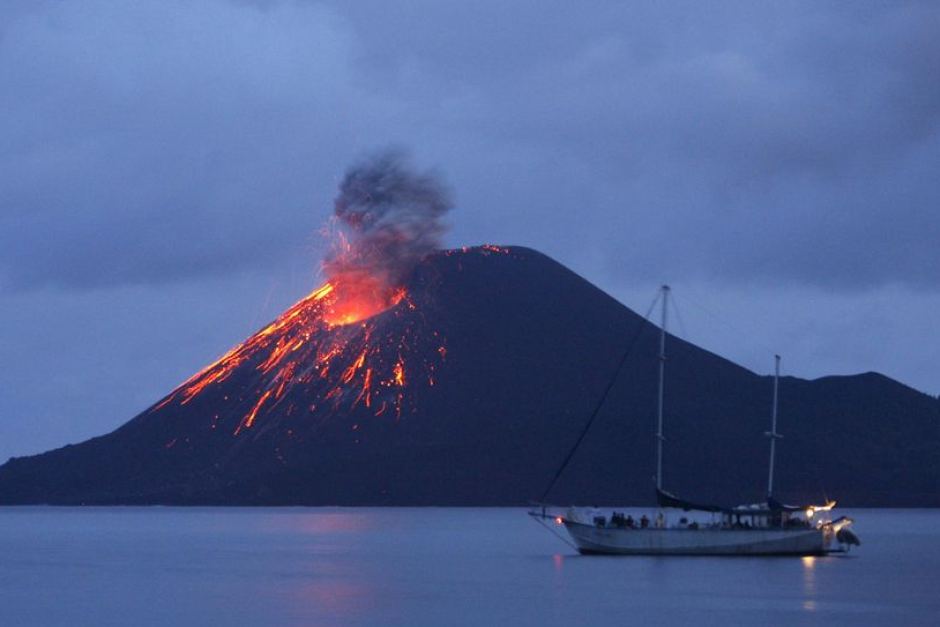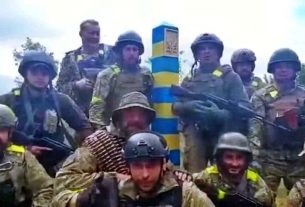National disaster management agency says 745 injured after tsunami, which could be linked to eruption of Anak Krakatoa
Dozens of people have been killed and hundreds injured after a tsunami struck tourist beaches and coastal areas around Indonesia’s Sunda Strait on Saturday night.
Officials said 168 people had been killed after a volcanic eruption thought to have been caused by an underwater landslide sent waves surging towards the coastlines of Java and Sumatra islands. Some 745 are thought to be injured and at least 20 people are unaccounted for, the country’s disaster management agency said. Reports said the wave swept away hundreds of homes and hotels, raising the prospect that the death toll will rise in the days ahead. .
The worst affected area was the Pandeglang region of Banten province in Java, which encompasses the Ujung Kulon national park and popular beaches, Indonesia’s disaster management agency said. Of the 62 reported deaths, at least 33 were in Pandeglang. Television footage showed roads blocked by debris from damaged houses, overturned cars and fallen trees. The water washed away an outdoor stage where a local rock band was performing, killing at least one musician. Other people who had been watching the band on the beach were missing. In the city of Bandar Lampung on southern Sumatra, hundreds of residents took refuge at the governor’s office.
Muhammad Bintang, who was at Carita beach on the west coast of Java when the wave hit, described a sudden surge of water that plunged the tourist spot into darkness. “We arrived at 9pm for our holiday and suddenly the water came – it went dark, the electricity is off,” the 15-year-old said. “It’s messy outside and we still cannot access the road.” Reports said the waves had “heavily damaged” 430 homes, nine hotels and 10 vessels.
The tsunami, which struck at about 9.30pm local time on Saturday, is believed to have been caused by undersea landslides that followed a volcanic eruption on Anak Krakatoa, since there were no significant seismic tremors to indicate a tsunami was coming. The island volcano, one of 127 active volcanoes running the length of the Indonesian archipelago, emerged from the ocean half a century after an eruption on nearby Krakatoa in 1883. That eruption, thought to be one of the most violent volcanic events in history, killed more than 36,000 people.
Breaking Video: Tsunami wave crashes into a venue while a band performs in Indonesia.
Ben van der Pluijm, an earthquake geologist and a professor in the University of Michigan, said the tsunami may have been caused by a partial collapse of Anak Krakatau. “Instability of the slope of an active volcano can create a rock slide that moves a large volume of water, creating local tsunami waves that can be very powerful. This is like suddenly dropping a bag of sand in a tub filled with water,” he said.
Anak Krakatau, which is located roughly halfway between Java and Sumatra, has been spewing ash and lava for months. The disaster agency said the size of the tsunami may have been exacerbated by abnormally high tide because of the full moon. According to a statement from Indonesia’s meteorology, climatology and geophysics agency (BMKG), “the tsunami hit several areas of the Sunda Strait, including beaches in Pandeglang regency, Serang, and South Lampung”. The Sunda Strait, between the islands of Java and Sumatra, connects the Java Sea to the Indian Ocean.

Endan Permana, the head of the national disaster agency in Pandeglang, said police were providing immediate assistance to victims in Tanjung Lesung in Banten province, a popular tourist getaway not far from Jakarta. “Many are missing,” Permana said. The BBC reported that footage posted by the head of communications for the disaster agency, Sutopo Purwo Nugroho, showed the aftermath of the tsunami, with flooded streets and an overturned car.
Øystein Lund Andersen, a Norwegian photographer who was in the area, wrote on Facebook that he was taking pictures of the volcano when he suddenly saw a big wave come toward him. “I had to run, as the wave passed the beach and landed 15-20m [metres] inland.
“Next wave entered the hotel area where I was staying and downed cars on the road behind it. Managed to evacuate with my family to higher ground through forest paths and villages, where we are taken care of [by] the locals. We’re unharmed, thankfully.”
Alif, a resident in Pandeglang district who goes by one name, said told MetroTV station that many people were still searching for missing relatives. Dramatic footage posted on social media captured the moment when the waves washed away the stage where local rock band Seventeen was performing. “The water washed away the stage which was located very close to the sea,” the band said in a statement. “The water rose and dragged away everyone at the location. We have lost loved ones, including our bassist and manager … and others are missing.”

The disaster mitigation agency said it was still compiling information on the tsunami’s impact and that there was a “possibility that data on the victims and damage will increase”. The agency added: “Heavy equipment is being deployed to assist in evacuation and emergency repairs. BMKG and the Geological Agency are carrying out studies to ascertain the causes of the tsunamis and possible follow-up.”
Authorities have warned residents and tourists in coastal areas around the Sunda Strait to stay away from beaches, and a high-tide warning remains in place until 25 December. Indonesia sits on the seismically active Pacific “ring of fire” and is regularly hit by earthquakes and tsunamis. In September, at least 832 people were killed by a quake and tsunami that hit the city of Palu on the island of Sulawesi, which is just east of Borneo.
In 2004, a tsunami triggered by a magnitude-9.3 undersea earthquake off the coast of Sumatra killed 220,000 people in countries around the Indian Ocean, including 168,000 in Indonesia.





